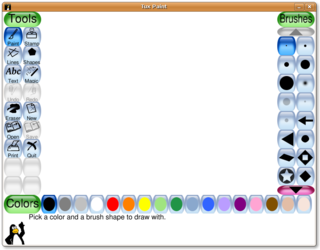DocBook is a semantic markup language for technical documentation. It was originally intended for writing technical documents related to computer hardware and software but it can be used for any other sort of documentation.
ScriptBasic is a scripting language variant of BASIC. The source of the interpreter is available as a C program under the LGPL license.

A slide show is a presentation of a series of still images on a projection screen or electronic display device, typically in a prearranged sequence. The changes may be automatic and at regular intervals or they may be manually controlled by a presenter or the viewer. Slide shows originally consisted of a series of individual photographic slides projected onto a screen with a slide projector. When referring to the video or computer-based visual equivalent, in which the slides are not individual physical objects, the term is often written as one word, slideshow.
S5 is an XHTML-based file format for defining slideshows. It was created by Eric A. Meyer as an alternative to the browser-centric Opera Show Format. S5 is not a presentation program, but fulfills the same purpose in combination with a standards-compliant web browser.
The file command is a standard program of Unix and Unix-like operating systems for recognizing the type of data contained in a computer file.

Tux Paint is a raster graphics editor geared towards young children. The project was started in 2002 by Bill Kendrick who continues to maintain and improve it, with help from numerous volunteers. Tux Paint is seen by many as a free software alternative to Kid Pix, a similar proprietary educational software product.

Microsoft Office 2007 is a version of Microsoft Office, a family of office suites and productivity software for Windows, developed and published by Microsoft. It was released to manufacturing on November 3, 2006; it was subsequently made available to volume license customers on November 30, 2006, and later to retail on January 30, 2007, the same respective release dates of Windows Vista. It was preceded by Office 2003 and succeeded by Office 2010.
Beamer is a LaTeX document class for creating slides for presentations.
Corel Presentations is a presentation program akin to Microsoft PowerPoint and OpenOffice.org Impress. The current release, version X6, is available only as part of the Corel's WordPerfect Office productivity suite.
PowerPoint animation is a form of animation which uses Microsoft PowerPoint and similar programs to create a game or movie. The artwork is generally created using PowerPoint's AutoShape features, and then animated slide-by-slide or by using Custom Animation. These animations can then be shared by transferring the PowerPoint file they were created in, and can be viewed with PowerPoint or Microsoft's free PowerPoint Viewer.

Siag Office is a tightly integrated free software office package for Unix-like operating systems. It consists of the spreadsheet SIAG, the word processor Pathetic Writer (PW), the animation program Egon Animator, the text editor XedPlus, the file manager Xfiler and the previewer Gvu.

Conky is a free software desktop system monitor for the X Window System. It is available for Linux, FreeBSD, and OpenBSD. Conky is highly configurable and is able to monitor many system variables including the status of the CPU, memory, swap space, disk storage, temperatures, processes, network interfaces, battery power, system messages, e-mail inboxes, Arch Linux updates, many popular music players, weather updates, breaking news, and much more. Unlike system monitors that use high-level widget toolkits to render their information, Conky is drawn directly in an X window. This allows it to consume relatively fewer system resources when configured similarly.

Uzbl is a free and open-source minimalist web browser designed for simplicity and adherence to the Unix philosophy. Development began in early 2009 and is still considered in alpha software by the developers. The core component of Uzbl is written in C, but other languages are also used, most notably Python. All parts of the Uzbl project are released as free software under the GNU General Public License version 3.

Hollywood is a commercially distributed programming language developed by Andreas Falkenhahn which mainly focuses on the creation of multimedia-oriented applications. Hollywood is available for AmigaOS, MorphOS, WarpOS, AROS, Windows, Mac OS X, Linux, and Android. Hollywood has an inbuilt cross compiler that can automatically save executables for all platforms supported by the software. The generated executables are completely stand-alone and do not have any external dependencies, so they can also be started from a USB flash drive. An optional add-on also allows users to compile projects into APK files.
Microsoft Office shared tools are software components that are included in all Microsoft Office products.

OpenCards is a free spaced repetition flashcard program. The software is similar to SuperMemo, Anki or Mnemosyne.
Impressive is a free and open-source software that displays presentation slides with 3D-effects. It is a lightweight and easy to use console presentation software with focus on PDF documents and images. It was started by Martin Fiedler in 2005.











